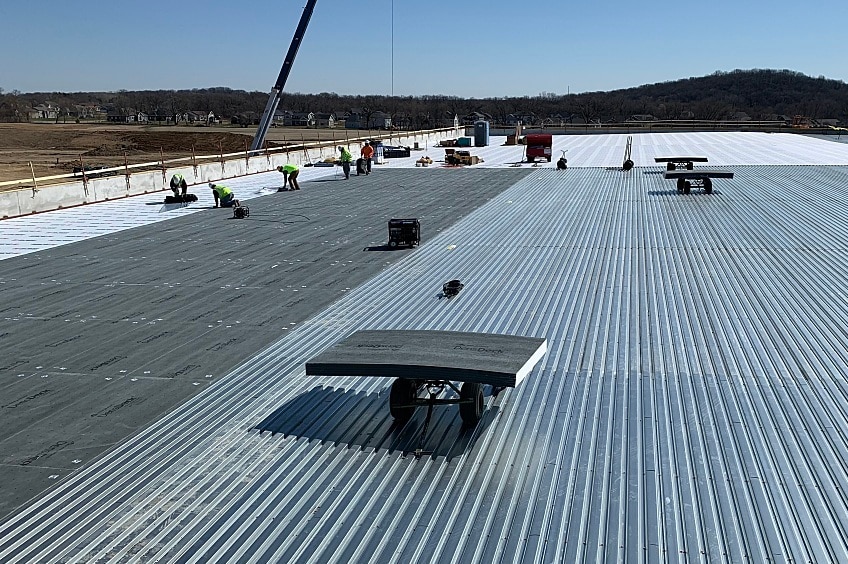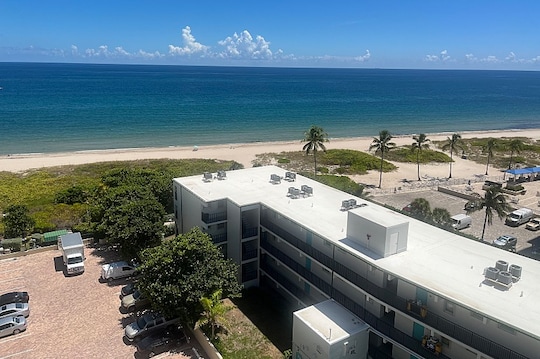
Roof systems require a number of performance properties, in addition to keeping water out of a building. Those properties include fire resistance, wind resistance, impact resistance, and R-value of the installed system, to name a few.
Often overlooked when installing a roof system over a steel roof deck is the flute-span capability of insulation and rigid boards that are placed directly on top of a steel roof deck. The selection of an appropriate material to be installed over the gaps in steel roof decks (the flutes) is important during both construction and the life of the roof.
Steel Roof Deck Types
Commercial steel roof decks come in various sizes, profiles, material gauges, finishes, and loading capabilities. Figure 1 presents examples from the Steel Deck Institute (SDI)1 of four of the most common types of steel roof deck profiles. Using SDI nomenclature (which is slightly different from the names used by NRCA [National Roofing Contractors Association]), they are as follows:
• Wide-rib steel deck (Type B)
• Intermediate-rib steel deck (Type F)
• Narrow-rib steel deck (Type A)
• Deep-rib steel deck (Type N or 3DR*) *according to NRCA
Figure 1: Steel roof deck profiles from the Steel Deck Institute (SDI). Figure: Reprinted with permission from SDI. 2016. Manual of Construction with Steel Deck. 3rd ed.
Most of the steel roof decks used for North American commercial buildings are Type B decks, which are 1½ in. deep with 6 in. rib spacing. The top flange of a Type B deck is 3½ in. wide, which leaves 2½ in. that needs to be spanned by the material installed directly on the steel roof deck.
Steel Roof Deck Geometry
The geometry of a steel roof deck provides much of its structural capacity and is one of the primary reasons that a steel roof deck can span between structural supports that are spaced 5 or 6 ft apart. Although the strength and thickness of the steel are important factors, the geometry of the steel roof deck is critical. Consider how flexible a flat piece of steel of the same strength and thickness as the steel in a roof deck would be, and how much deflection would occur when that flat piece spanned 5 to 6 ft (Fig. 2).
Figure 2: Isometric view of a common steel roof deck.
Using Products Directly Over Steel Decks
The flute-span capability of products is specific to manufacturer, product type, surfacing, and thickness. It is difficult to provide a comprehensive list of materials; however, Tables 1 through 6 provide information based on material type and product thickness; the tables were derived from product manufacturers' publicly available information, but they are not exhaustive. The information varies based on manufacturer. Flute-span capability should be verified by the manufacturer of their specific product.
Flute-Span Capability During Construction
When working with Type B decks, roofing contractors typically place polyisocyanurate (polyiso) insulation or a rigid board (for use as a fire barrier) directly over the steel roof deck. This roofing system configuration is very common, and the potential for a misstep is low because both polyiso insulation and rigid boards can generally span standard Type B decks.
The concept of flute-span capability is directly associated with the strength of the material being installed and its ability to handle the anticipated loads where the material is not supported by the top flange of the roof deck (that is, over the flute). This capability is often needed during construction but not necessary for the completed roofing system; therefore, flute-span capability may be a larger concern during construction than after the roof system is completed.
Acoustical Decks
When a designer moves from common types of steel roof decks to other styles to meet a design or building need, that design choice can cause challenges for the roofing professional with regard to flute-span capability. For example, a less-common steel roof deck is a dovetail acoustical roof deck, which has a very narrow top flange and a very wide rib opening (Fig. 3). This type of deck can be an appealing option for some designs because it has a smooth linear plank look on its underside and because it can—with flute fill—provide acoustical benefits.
An acoustical roof-deck profile is quite different from common steel roof decks. The flutes of an acoustical roof deck are wide (relative to the four common steel roof types) and the top flange is quite small. This profile accommodates the use of sound-deadening insulation in the flutes (Fig. 3).
Figure 3: The dimensions of an acoustical dovetail roof deck (bottom); use of sound-deadening insulation in the flutes (top). Figure: CanAm Steel Corporation.
While the acoustic benefit is important for certain buildings, the choice of material that is installed directly on this type of deck should be carefully specified to ensure the long-term performance and constructability of the roof system. There are very few materials that can span the 4⅝ in. rib opening.
Another consideration is how the first layer of material will be attached given the small top flange on an acoustical deck. Ensuring that fasteners are properly engaged into the top flute of an acoustical deck that has a top flute width of 1½ in. can be challenging.
Roof System Approval Listings
Approval listings promulgated by roofing manufacturers provide a wealth of information. One provider of approval listings is the Directory of Roofing Assemblies (DORA: dora-directory.com). Figure 4 is an example from an approval listing in DORA that provides detailed information about the roof deck used for that Listing, including the deck type and deck attributes. Notice that one of the attributes is that the roof deck is Type B. The listing also identifies the minimum thickness of the layer of material that is installed directly to the roof deck: minimum 2-in.-thick polyiso. From the information in Table 4 above, we can see that this polyiso thickness exceeds the minimum thickness required to span a 2½-in.-wide flute.
Figure 4: An example of an approval listing in the Directory of Roofing Assemblies (dora-directory.com).
Another approval listing tool is RoofNav (roofnav.com). See Figures 5 and 6. In this example Listing, the steel deck must be 22 to 18 gauge and is listed as wide rib, which is Type B. The securement of the side lap between two steel roof deck panels is also provided, as is the method of attachment of the steel roof deck to the structure. Clicking "View" for the steel deck (Fig. 6) reveals additional information (Fig. 7). The steel deck for this example is required to be a minimum 33 ksi steel with a maximum span of 6 ft, minimum depth of 1.5 in., and width within the range of 24 to 36 in. Not all listings provide the specific deck type as is shown in the example listing. In those cases, the RoofNav user must investigate further to determine which steel roof deck profile is appropriate.
It's worth noting that new steel roof decks are now minimum 40 ksi steel; this approval remains relevant because the required grade is listed as "minimum."
Figure 5: Summary of an approval listing in Roof Nav (roofnav.com).
Figure 6: Detailed information about the roof deck from the RoofNav approval listing shown in Fig. 5.
Figure 7: Additional information provided from the "View" link for the steel roof deck.
Conclusion
Roofing professionals should take care to always understand and familiarize themselves with the specifics of the steel roof deck that is being specified and installed. Just because plans and specs may call out "steel deck" does not mean the rib opening will necessarily be 2½ inches (Type B). The information in Table 1 to 6 can help roofing professionals avoid problems because of a material's flute-span capability, or lack thereof. Roofing professionals are advised to pay attention to the minutiae of a project's specification and details, and to investigate the specifics of what is being called out as "steel deck." Without attention to detail, the material used could be incorrect for the specific type of steel roof deck installed as the substrate for the roofing system.
Read the full article here starting on page 24: Interface February 2022_Steel Roof Decks and Flute-Span Capability
Credit: Steel Roof Decks and Flute-Span Capability, IIBEC Interface Magazine February 2022, pg. 24-29.



